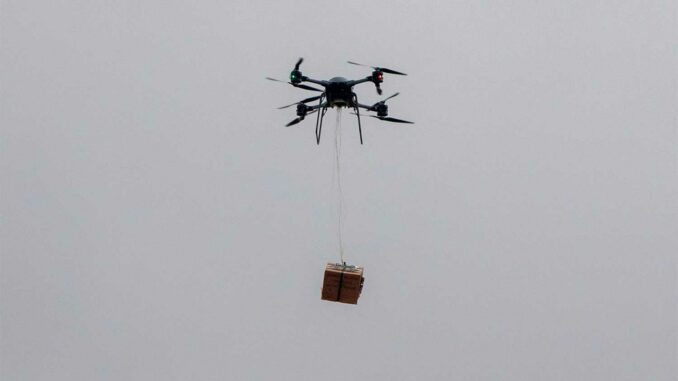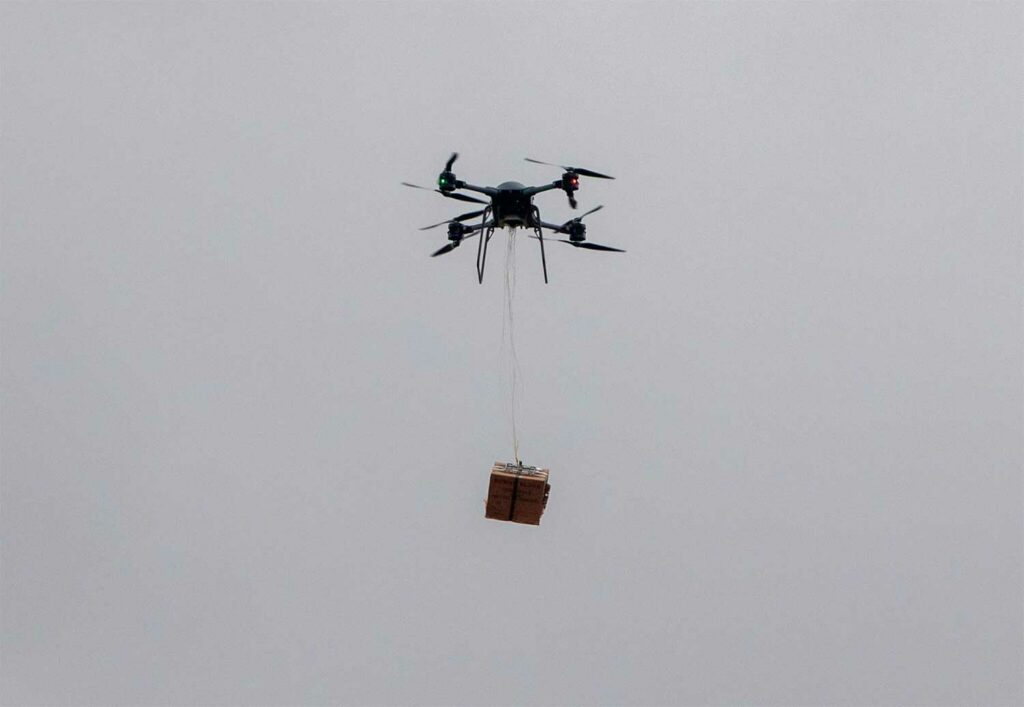
The US Army is experimenting with drone blood deliveries in Lithuania as part of advanced medical support during the DEFENDER 25 exercise.
During the Swift Response 2025 exercise in Pabradė, Lithuania, a US Army TRV-150 drone carried out a simulated blood delivery to a combat zone, demonstrating a new method of medical resupply in hostile environments. This demonstration is part of the broader DEFENDER 25, a European strategic exercise involving 25,000 military personnel from 29 NATO partner countries. The aim is to test rapid deployment capabilities, inter-allied coordination, and the use of unmanned technologies to support survival in the field, particularly when conventional evacuation methods are unavailable.
A strategic demonstration integrated into DEFENDER 25
On May 15, 2025, a TRV-150 drone was used to drop a simulated cargo of blood at a forward position as part of the Swift Response exercise, organized in the Pabradė military training area in Lithuania. This operational test aimed to validate the ability of drones to carry out Category VIII medical deliveries – NATO’s designation for pharmaceuticals, blood, and critical care equipment.
This initiative is part of the DEFENDER 25 program, the US Armed Forces’ main annual exercise in Europe. The operation brings together approximately 25,000 soldiers from 29 allied and partner nations, deployed in 15 countries between May 11 and June 24, 2025. Three main maneuvers are included: Swift Response, Immediate Response, and Saber Guardian.
The strategic objective is twofold:
- to test the responsiveness and coordination of command chains in a multi-domain environment (air, land, cyber, information),
- and to test agile logistics solutions in high-intensity warfare conditions.
The simulated delivery of blood is a technical proof of concept, aimed at demonstrating that unmanned systems can complement or even replace traditional logistics chains in degraded environments.
A tactical drone for advanced medical missions
The TRV-150 drone used for the demonstration is a heavy quadcopter unmanned aerial vehicle (UAV) designed for short- and medium-range tactical resupply missions. Built for hostile environments, it has the following capabilities:
- payload: up to 68 kg (150 lb),
- operational range: approximately 50 kilometers,
- flight altitude: between 60 and 150 meters,
- drop accuracy: <5 meters in marked areas.
The TRV-150 can transport thermally regulated containers, which is essential for keeping blood between +1°C and +6°C, the temperature required for transfusions. It is also equipped with autonomous navigation systems based on inertial navigation, differential GPS, and obstacle avoidance sensors to ensure delivery in urban areas or over rough terrain.
Its integration into military exercises aims to evaluate the feasibility of its use on the front line, in direct support of exposed combat units, often out of reach of MEDEVAC helicopters, either for safety reasons or in the event of air resource saturation.

A vital issue in combat medicine
The ability to quickly deliver blood or critical medical supplies to the field is a decisive factor in survival. In conventional operations, the time between injury and the first transfusion is often more than 30 minutes, which can be fatal in cases of massive blood loss.
The use of drones such as the TRV-150 would reduce this time to less than 10 minutes, particularly in cases where evacuation by road is impossible and helicopter transport is unavailable or too risky. This capability is considered essential for future high-intensity conflicts, where supply lines could be fragmented and humanitarian corridors inaccessible.
The experience in Lithuania demonstrates that logistics drones are no longer a marginal experiment, but rather an integrated tool in advanced medical support doctrine.
An operational precedent: the Ukrainian example
The US Army is drawing direct inspiration from experiences gained by Ukraine in real combat zones. In 2023, a light transport drone was used by the 14th Independent Mechanized Brigade “Chervona Kalyna” to deliver an emergency blood supply to a seriously wounded soldier near Pokrovske, under continuous Russian bombardment.
According to reports published by Militarnyi, ground medical units were unable to reach the wounded soldier. The drone became the only possible means of delivering the blood for a life-saving transfusion. This operation was a world first in a context of active warfare and was closely observed by several Western military leaders.
This Ukrainian initiative demonstrates:
- the technical viability of the concept,
- its immediate impact on frontline survival,
- and its ease of implementation with limited resources.
NATO armies are now evaluating the integration of these systems into their medical doctrines, both in external operations and in territorial defense.
Towards a NATO doctrine for drone-based medical support
The demonstration in Lithuania marks a step towards the widespread adoption of drone-based medical solutions in allied doctrines. Several European armed forces, including those of Poland, Norway, and France, are participating in the validation of protocols for use, delivery security, and NATO standardization.
The next operational milestones will include:
- automated flight tests in a jammed environment (electronic jamming),
- qualification of medical containers to STANAG standards,
- and the development of an allied manual for unmanned medical logistics.
At the same time, industrial partnerships are underway with companies such as Zipline, Elroy Air and AeraMed, which are developing platforms capable of delivering over 150 km with an accuracy of less than 3 meters, in a standard time of less than 20 minutes.
War Wings Daily is an independant magazine.